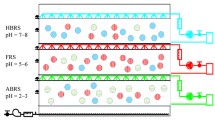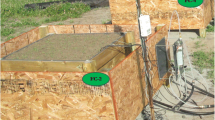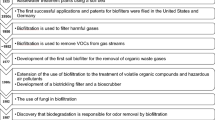Abstract
A great deal of research has been directed towards the problem of reduction and control of volatile organic compounds (VOCs). The aim of this research is to find a process that is both efficient and inexpensive in comparison with traditional air treatment technologies.
Our biofilter (one stage system, 2 m in height) is an aerobic system for waste gases containing VOCs using the degradation properties of microbial flora (assorted cultures of Bacillus, Micrococcus, Acinetobacter and yeast). In this process, polluted gas diffuses across a filter bed into which a microbial culture has previously been introduced. Peat is the medium of choice for inoculation with microorganisms because of its adsorption and absorption properties, ability to retain moisture, and buffering capacity. Furthermore, the peat utilized is spherical in shape; thus, it is possible to avoid problems related to compacting.
The objective of this study was to eliminate VOCs emitted from a rotogravure process. We were able to achieve promising results from biofiltration of two types of VOCs (a mixed solvent containing isopropyl acetate and 1-nitropropane, and the solvent: 1-nitropropane). The results obtained indicate that the elimination of nitropropane and the mixed solvent in the biofilter are considered to follow zero-order kinetics with reaction rate limitation and diffusion rate limitation, respectively.
Similar content being viewed by others
References
Dharmavaram, S.: June 1991, Proceedings from the 84th Annual Meeting Exhibition Air and Waste Management Association, Vancouver, BC 91-103-2.
Hodge, D. S., Medina, V. F., Islander, R. L. and Devinny, J. S.: 1991, Environmental Techno. 12, 655.
Ottengraf, S. P. P. and van den Oever, A. H. C.: 1983, Biotechnol. Bioeng. 25, 3089.
Ottengraf, S. P. P., Meesters, J. J. P., van den Oever, A. H. C. and Rozema, H. R.: 1986, Bioprocess Eng., 61.
Ottengraf, S. P. P., van den Oever, A. H. C. and Kempenaars, F. J. C. M.: 1984, in: Houwink, E. H. and Van den Meer, R. R. (eds.), Innovations in Biotechnology, Elsevier Science, Amsterdam. pp. 157-167.
Sharefdeen, Z. and Baltzis, B.C.:1993, Biotechno. Bioeng. 41, 512.
Sly, L. I., Bryant, Z. J., Cox, J. M. and Anderson, J. M.: 1993, Appl. Microbiol. Biotechnol. 39, 400.
Zilli, M., Convert, A., Lodi, A., Borghi, M. D. and Ferraiolo, G.: 1993, Biotechno. Bioeng. 41, 693.
Author information
Authors and Affiliations
Rights and permissions
About this article
Cite this article
Wu, G., Chabot, J.C., Caron, J.J. et al. Biological Elimination of Volatile Organic Compounds from Waste Gases in a Biofilter. Water, Air, & Soil Pollution 101, 69–78 (1998). https://doi.org/10.1023/A:1004914919615
Issue Date:
DOI: https://doi.org/10.1023/A:1004914919615




